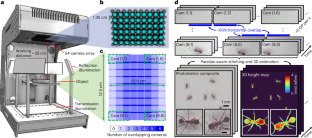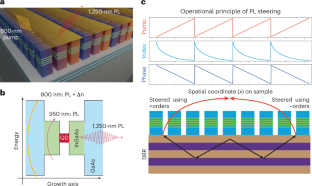2023-03-20 デューク大学(Duke)
マルチカメラアレイ顕微鏡(MCAM)は、3D動画の記録や小動物の行動を細胞レベルで観察したい研究者に新しい可能性をもたらしました。MCAMの最新バージョンは、プロトタイプよりも高速で高解像度である。研究者たちは、顕微鏡が生成するデータに対して誰もが試せるように、アルゴリズムをオープンソース化した。
<関連情報>
- https://pratt.duke.edu/about/news/3d-gigapixel-microscope
- https://www.nature.com/articles/s41566-023-01171-7
毎秒数ギガピクセルで自由に動く生物の並列計算による3Dビデオ顕微鏡観察 Parallelized computational 3D video microscopy of freely moving organisms at multiple gigapixels per second
Kevin C. Zhou,Mark Harfouche,Colin L. Cooke,Jaehee Park,Pavan C. Konda,Lucas Kreiss,Kanghyun Kim,Joakim Jönsson,Thomas Doman,Paul Reamey,Veton Saliu,Clare B. Cook,Maxwell Zheng,John P. Bechtel,Aurélien Bègue,Matthew McCarroll,Jennifer Bagwell,Gregor Horstmeyer,Michel Bagnat & Roarke Horstmeyer
Nature Photonics Published:20 March 2023
DOI:https://doi.org/10.1038/s41566-023-01171-7

Abstract
Wide-field-of-view microscopy that can resolve three-dimensional (3D) information at high speed and spatial resolution is particularly desirable for studying the behaviour of freely moving organisms. However, it is challenging to design an optical instrument that optimizes all these properties simultaneously. Existing techniques typically require the acquisition of sequential image snapshots to observe large areas or measure 3D information, thus compromising speed and throughput. Here we present 3D-RAPID, a computational microscope based on a synchronized array of 54 cameras that can capture high-speed 3D topographic videos over a 135 cm2 area, achieving up to 230 frames per second at a spatiotemporal throughput exceeding 5 gigapixels per second. 3D-RAPID employs a 3D reconstruction algorithm that, for each synchronized snapshot, fuses all 54 images into a composite that includes a co-registered 3D height map. The self-supervised 3D reconstruction algorithm trains a neural network to map raw photometric images to 3D topography using stereo overlap redundancy and ray-propagation physics as the only supervision mechanism. The reconstruction process is thus robust to generalization errors and scales to arbitrarily long videos from arbitrarily sized camera arrays. We demonstrate the broad applicability of 3D-RAPID with several collections of freely behaving organisms: ants, fruit flies and zebrafish larvae.



